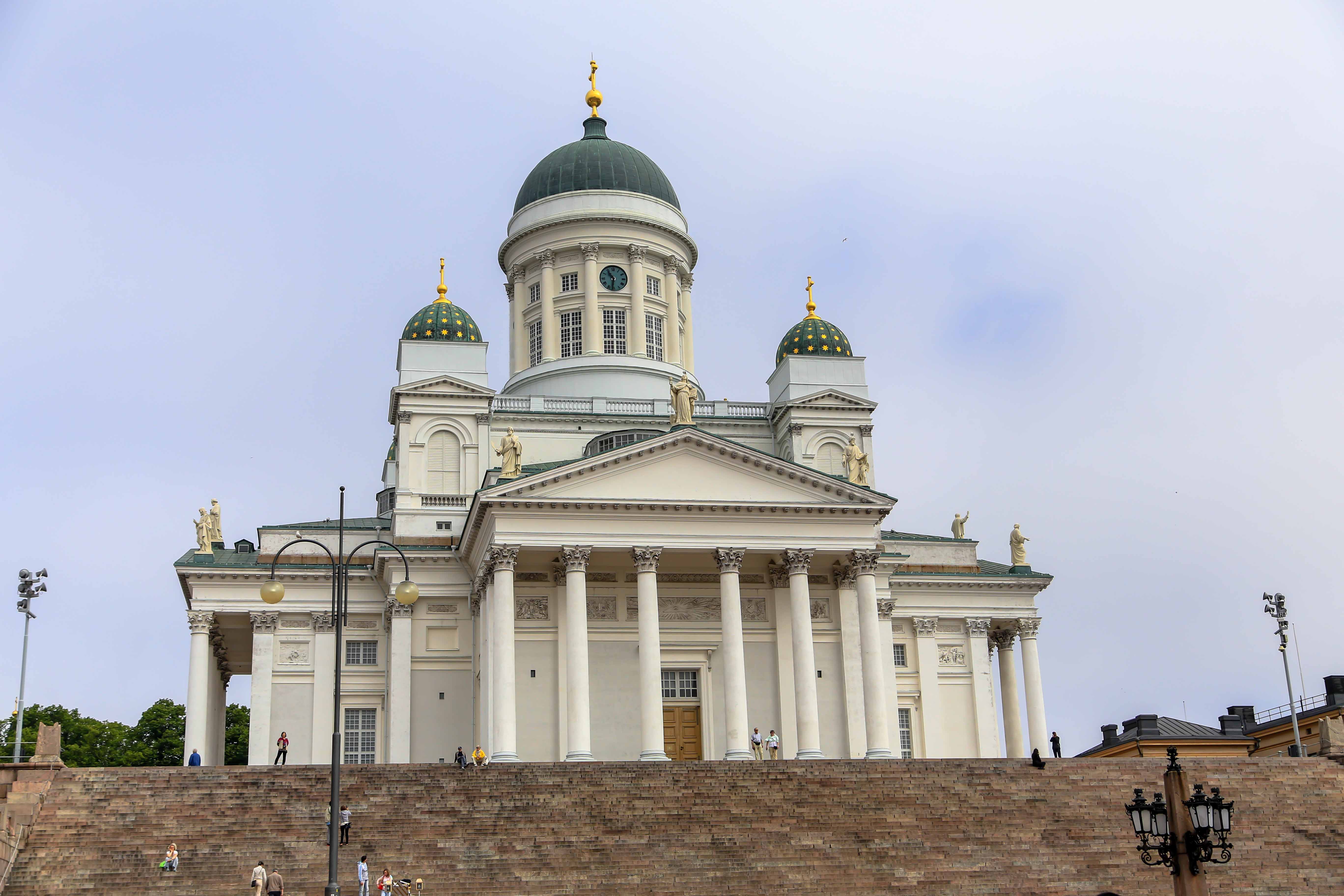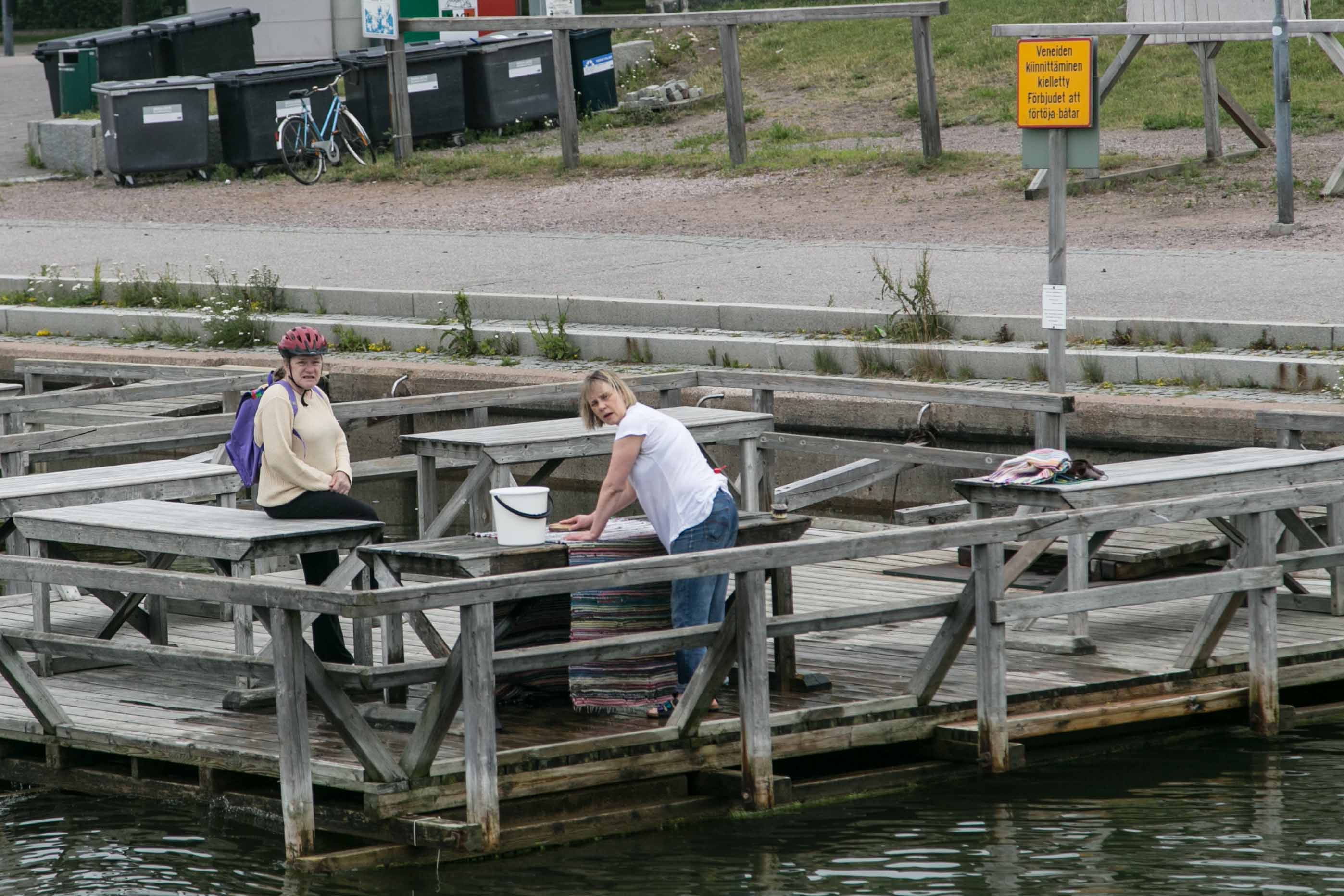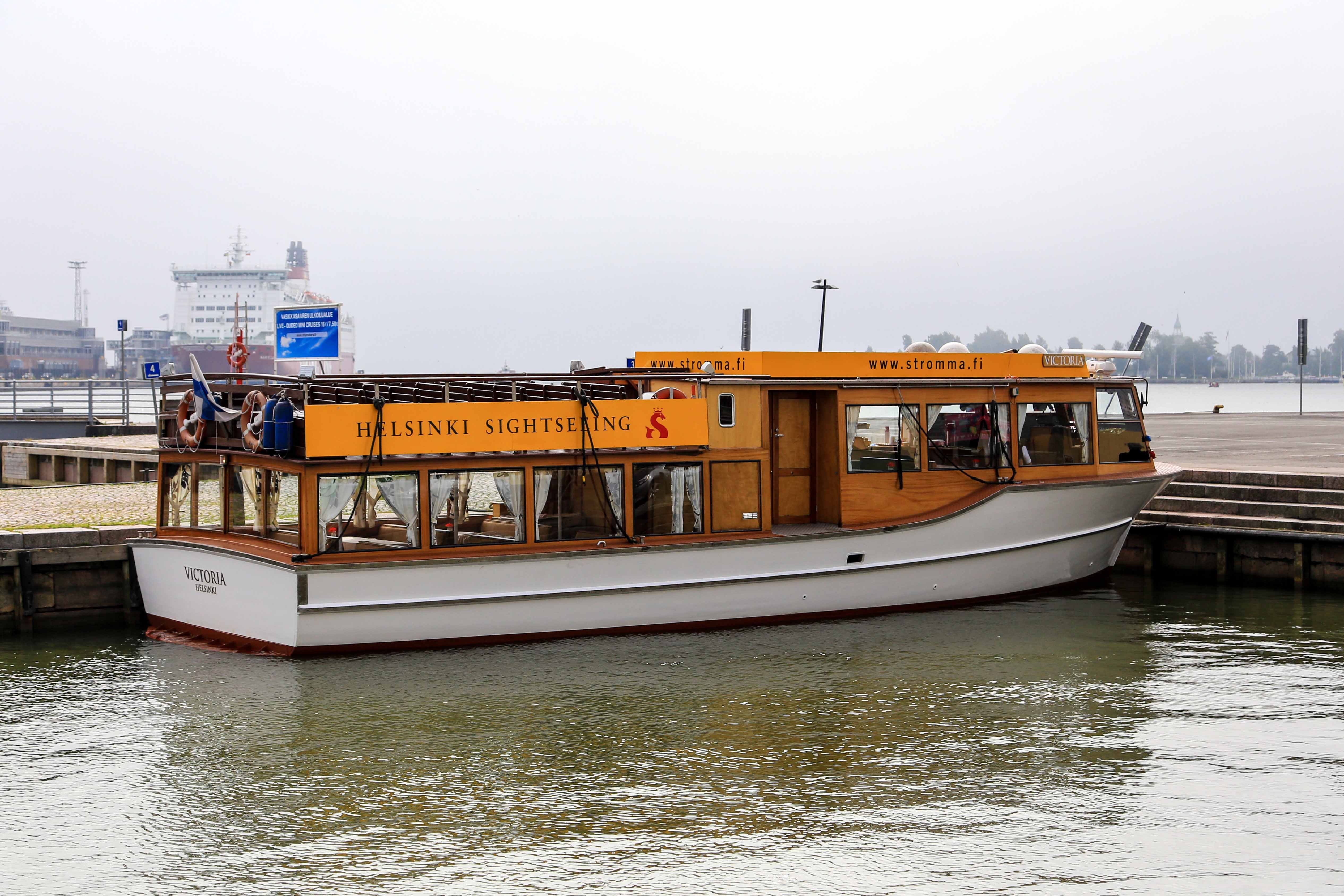We arrived in Helsinki Finland this morning and departed immediately for a brief bus ride to a dock area where we boarded a small boat for a harbor tour. Like Stockholm, Copenhagen and Oslo, there are many islands or an archipelogo surrounding Helsinki which has over 330 of islands. Our tour was going to pass by the largest and closest of these islands.
Helsinki is the capital and largest city of Finland. It is located approximately 50 miles north of Tallinn, Estonia, 250 miles east of Stockholm, and 190 miles west of St. Petersburg, Russia. Helsinki has close historical connections with these three cities. King Gustav I of Sweden established Helsinki as a trading town in 1550. He intended it to be a rival to the Hanseatic city of Reval (known now as Tallinn). Little came of the plans, as Helsinki remained a tiny town plagued by poverty, war, and diseases.
The plague of 1710 killed the greater part of the inhabitants of Helsinki. The 18th century construction of the naval fortress, Suomenlinna, built on an island located just on the edge of the harbor, helped improve Helsinki’s status. But it was not until Russia defeated Sweden in the Finnish War and annexed Finland in 1809 that the town began to develop into a substantial city. During the war, Russians besieged the Suomenlinna fortress and most of the city was devastated in a fire in the early 1800’s.
Czar Alexander I of Russia moved the Finnish capital from Turku to Helsinki in 1812 to reduce Swedish influence in Finland and bring the capital closer to St. Petersburg. This transformation is highly apparent in the downtown core, which was rebuilt in neoclassical style to resemble St. Petersburg.
Helsinki was bombed several times during World War II. Between 1939–1945 Finland fought three wars, two against the Soviet Union and one against Germany. In February 1944 over 2,000 bombers dropped more than 16,000 bombs on Helsinki. The Finns managed to lure many of the bombers away from the core city by lighting fires on the islands outside the city. Only 530 bombs fell within the city itself. The majority of the population of Helsinki had left the city and the casualty figures were low. Unlike Tallinn, which was bombed during the war but luckily (in some ways) did not sustain major damages to their old town center, Helsinki has been completely rebuilt and is a completely modern city.
Finns have a very practical view of history. Since they have been taken over many times over the past few hundred years, the tend to value all the historical figures whether it is a Russian Czar, Karl Marx or one of their own. Can’t do anything about the past so let’s celebrate everything! Sort of a refershing viewpoint and it makes for lots of nice statues around town. One example is that all road signs, which are on the sides of buildings, are shown in both Finnish and Swedish language. Students also learn both languages since their countries and cultures were combined in much of their history.
One interesting activity that Fins do is to come down to the waterfront and place their wool rugs on permanent wooden tables and wash them using stiff brushes and soapy water. Seems that this is a very social activity and on weekends you can see lots of activity here. The picture in the gallery shows there was only one woman when we passed them in the bus.
There were some high clouds when we arrived at the dock but as we began our boat ride the clouds lowered and it became thick with fog! In fact, at times our tour guides were giving us descriptions of things that we couldn’t see because we were in a white-out. The tour guides made light of it as they recounted many of the subjects they were covering during the harbor tour despite the lack of anything to see. It seems that Helsinkians have a good sense of humor and don’t take themselves too seriously.
One of the first things we saw was the Uunisaari sauna which is located on Uunisaari island (picture in gallery). To say the least, saunas (sow-na) are very popular in Finland and most of these cold weather countries. There are five million inhabitants of Finland and over 2 million saunas! Most people use the sauna at least once a week and they are can be coed (more typical for younger people), a family activity and almost always the participants are naked. Fins have no problem with nudity. It is also common to lightly whip one’s backside/legs with a small white birch branch to stimulate blood flow. You can see some birch branches on the J.L. Runeberg boat and the rear of the large ferry in the gallery. I guess they want to keep them handy in case a sauna comes up? On this island, this sauna is a popular place to sit in the sauna and then jump into the ice cold water. Repeat process until you are thoroughly sauna’d out.
When we reached the UNESCO World Heritage island of Suomenlinna, which was a sea fortress designed to prevent enemy ships from entering the harbor back in the 1700’s while Finland was part of Sweden and the most expensive construction project in Europe up to that point in time, we saw a submarine sitting up out of the water. This was the Vesikko, a WWII submarine that was built in Finland in 1933. There is an interesting story about Finnish submarines but the basics are that the Germans secretly used a Finnish company to design their submarines since they were banned from doing so on their own. While the Vesikko was purchased by the Finnish government, the Germans bought several others for their use in the war. Then, the Vesikko ended up being used to fight the Russians who were attempting to take over Finland. Hard to keep track of all that!
One interesting thing we learned is that the Baltic Sea has a much lower salinity level than other oceans of the world. In fact, the entire harbor freezes solid in the winter to the point where you can drive your car on it! Ice breakers are important and we saw several of their fleet in the harbor. They keep a path so that ferries can continue to bring people to their houses and larger ships can get to port. Finland is famous for their production of ice breakers and cruise ships, including the largest cruise ships in the world that hold over 5,000 people.
We were concerned from time to time as the fog was thick and the captain of our boat was very young! We also thought it strange that we didn’t hear any foghorns. Our apprehension lifted with the fog as finally, just before our tour ended, the sun started to shine through and we got glimpses of how beautiful this area really is. Fortunately, on the way back in we were able to see some of the sights the guides described.
At the end of the boat ride they dropped us off near the center of town and walked us to the old square that was bordered by a large church and some of their federal buildings. Next we left the group and walked about half a mile from the town square, up a hill to a beautiful Orthodox Christian church. The religion here is mostly Lutheran and Orthodox and, since Dale grew up going to Lutheran school and church they thought it would be good to check out the church. The church was spectacular sitting on it’s perch above the city. At this point the skies were gloriously blue with fantastic white puffy clouds. The church was breathtaking inside and out and we had the special treat of being able to go inside during a church service. No pictures were allowed inside but the service looked just like a typical Catholic Mass.
We walked back to the town square area noting the fantastic park replete with outdoor cafes, lots of benches filled with locals on a Sunday morning, statues, fountains and lots of trees. A little further and up a hill we waited for the Marina shuttle bus and took the short ride back to the ship. We got cleaned up and all dressed up and headed to the pool deck for the big pool party, complete with free drinks! Once again, we found that this group really likes free drinks! The pool deck was packed, the temperatures were not and the dress was pretty darn casual. We grabbed our Grey Gooses and headed for the Horizon Lounge on the top deck forward. Who did we run into but none other than our buddies Jim and Mo. We had a great time sharing our stories about St. Petersburg and Moscow while the captain masterfully steered Marina around a thick fog bank that popped up on the horizon. All too soon Jim and Mo headed to their favorite restaurant, Red Ginger, while we to ours, the Grand Dining room. We closed the place down and left once we realized that the entire crew was going to head to the Marina Lounge their stage show which culminated with the entire customer-facing crew on stage at the same time! Quite an impressive site. That’s out butler Vinod waving.
Margaret’s Top Picks:
Helsinki Full Gallery:



.jpg)


